


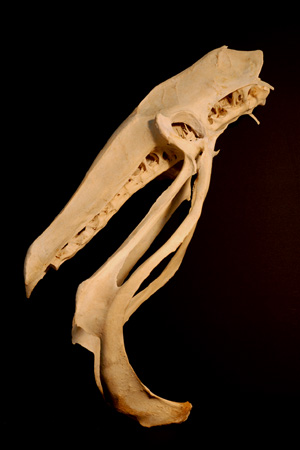
ダチョウ腰仙骨
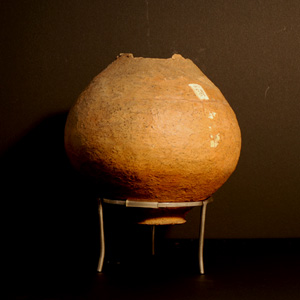
弥生町出土壷型土器(レプリカ)
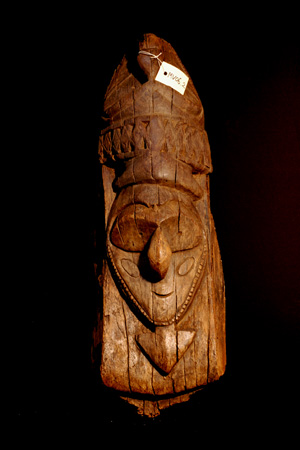
彫刻付きカヌー
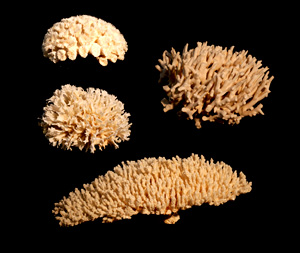
サンゴ
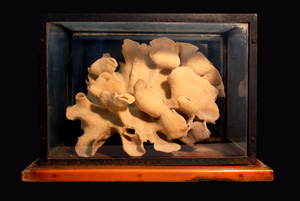
サンゴ
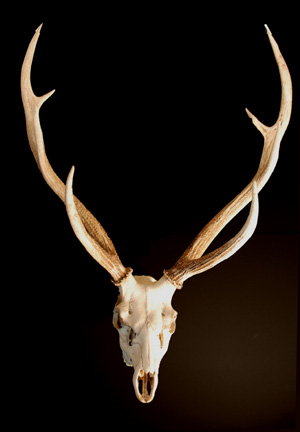
ニホンジカ頭骨
 展示標本 (2009.2.1〜2009.7.31)
展示標本 (2009.2.1〜2009.7.31)小ケース1: ダチョウ腰仙骨(ようせんこつ)
世界最大の鳥類、ダチョウの腰の骨である。ヒトを含む多くの哺乳類と異なって、胸の後方から尾にかけての背骨が、骨盤と癒合している。鳥類は体全体を軽量化するために、動かす必要のない体の後ろ半分を一体化させて、大きな腰仙骨を作る。進化の結果、飛ぶ能力を失ったダチョウも、腰の骨の形は祖先の鳥類の特徴を引き継いでいるといえるだろう。
Lumbosacral bone of the ostrich
This is a fused bone in the hip region of the ostrich, the largest bird in the world. Unlike the vertebrae of mammals including human, their posterior thoracic to caudal vertebrae are fused with pelvic bones. To make their body lighter, the posterior vertebrae, which do not actively function, are put together to make one large lumbosacral bone. Although ostriches lost their ability to fly as a result of the evolution, their skeleton of the posterior trunk and pelvic girdle areas keep the structure of those in their ancestors as birds.
小ケース2: 弥生町出土壺形土器(レプリカ)
いわゆる「最初の弥生土器」。この壺形の土器標本は、現在の東京大学浅野地区周辺の向ヶ岡弥生町(現文京区弥生)において、東京大学の予備門生徒の有坂![]() 蔵らが1884(明治17)年に発見したものである。当初から「弥生町出土の土器」として知られ、後日、先史考古学の発展と共に、「弥生式土器」といった土器形式、さらには「弥生時代」という時代名称のもととなった。1975(昭和50)年には国の重要文化財に指定された。本来、割れ口の上部にラッパ形の口縁部が続いていた。
蔵らが1884(明治17)年に発見したものである。当初から「弥生町出土の土器」として知られ、後日、先史考古学の発展と共に、「弥生式土器」といった土器形式、さらには「弥生時代」という時代名称のもととなった。1975(昭和50)年には国の重要文化財に指定された。本来、割れ口の上部にラッパ形の口縁部が続いていた。
The Yayoi pottery (replica)
This is the “type” or “first” specimen of Yayoi style pot, discovered in 1884 at Yayoi district, at or adjacent to the University of Tokyo campus. It was, then, of an unknown “new” pottery style intermediate between the seemingly older “stone age” (Jomon) and more recent pottery, and was nicknamed the “Yayoi pottery.” Active discussion in the latest 1800s led to the recognition of a new pottery style, culture, and prehistoric age, all of which came to be named after the initially found pot. Hence the Yayoi style pottery, the Yayoi culture, and the Yayoi period (500 B.C. to 300 A.D.)
小ケース3: 彫刻付きカヌー
パプア・ニューギニアのボサムン族が1960年代に使用していたカヌーの舳先。伝統的様式による人面彫刻が二つみられる。彫刻は祖先を表現したもので、航行の安全を祈願してほどこされた。オセアニア民族芸術を専攻するオランダ人研究者から寄贈された。
Canoe prow
The canoe of which this prow was part served for transport of people and
goods on the Ramu River, Papua New Guinea. It was originally collected
by a Dutch anthropologist from the Bosumn people in the 1960s. The two
classically sculpted ancestor faces functioned as a means of protection
for the canoe and its crew.
大ケース内の展示標本
サンゴ
サンゴは刺胞動物の1種であり、イソギンチャクやクラゲに近縁である。動物体は炭酸カルシウムの骨格を分泌し、サンゴ礁を形成する。大多数のサンゴは、遺伝的に同一な小さな個体(ポリプ)が集まってできる群体である。サンゴ自体はプランクトン食であるが、体内に褐虫藻を共生させており、褐虫藻が光合成により生産する有機物を利用して成長することができる。そのためには十分な光が必要であり、サンゴの生息域は熱帯域〜亜熱帯域の浅海に限られている。
Corals
Corals are a group of cnidarian animals which are phylogenetically close to sea anemones and jelly fish. Living animal secretes a hard skeleton of calcium carbontate and forms coral reefs. The majority of corals consist of genetically identical, small individuals called polyps. Each polyp feeds on planktons and also uses organic nutrients produced by photosynthestic symbiontic microalgae (zooxanthellae). Because the algae need intensive sunlight, the distribution of corals
is restricted to shallow-water tropical to subtropical areas.
ニホンジカ頭骨
北海道で収集されたニホンジカ、すなわちエゾシカの頭骨である。わが国のニホンジカは、北部に分布する集団が大きく、南へ行くほど小さくなるという、分布地と体サイズの間に明瞭な関係が見られる。この標本はオスの成体で、日本産としては最大級の大きさである。生きていた時には、肩の高さが130センチくらいにまで達していたと推測される。
Skull of the Sika deer
A skull of a Sika deer collected in Hokkaido (Ezo Sika deer). Their habitat and body size have a relationship; the northern populations are larger than southern ones in body size. This is a skull of an adult male and is one of the biggest specimens from Japan. The shoulder height of this animal is thought to be about 130 cm when it was alive.
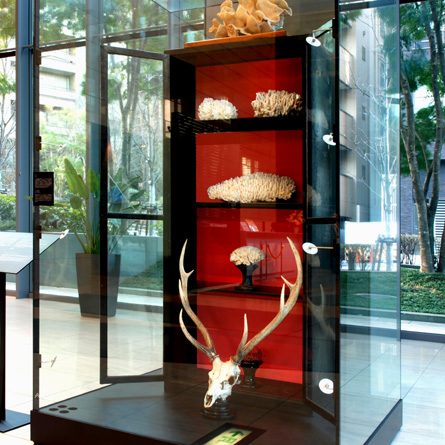
解説文執筆
諏訪 元 (本館教授、形態人類学) Gen Suwa (Professor)
西秋良宏 (本館教授、先史考古学) Yoshihiro Nishiaki (Professor)
遠藤秀紀 (本館教授、比較形態学、遺体科学) Hideki Endo (Professor)
佐々木猛智 (本館准教授、動物分類学)Takenori Sasaki (Associate professor)
松原始 (本館特任研究員、動物行動学)Hajime Matsubara (Affiliate researcher)
写真撮影
松本文夫 (本館特任准教授)Fumio Matsumoto (Affiliate associate professor)
2007年1月〜2007年7月
2007年7月〜2008年2月
2008年2月〜2008年8月
2008年8月〜2009年2月
2009年2月〜2009年7月
2009年8月〜2010年1月
2010年2月〜2010年7月
2010年8月〜2011年1月
2011年1月〜2011年7月
2011年8月〜2012年1月
2012年1月〜2012年7月
2012年8月〜2013年2月
2013年2月〜2013年8月
2013年8月〜2014年1月
2014年2月〜2014年11月
2014年11月〜2015年7月
2015年8月〜2016年1月
2016年2月〜2016年7月
今までのトップページの連続スライドショー
興和不動産本社におけるモバイルミュージアム(非公開)
ページの先頭に戻る